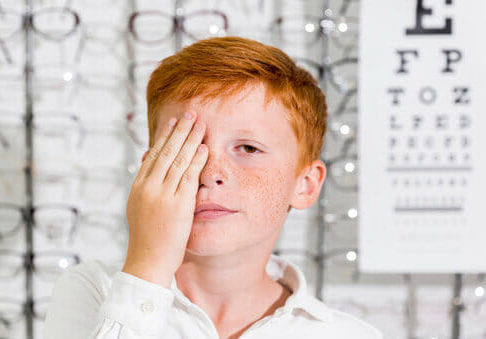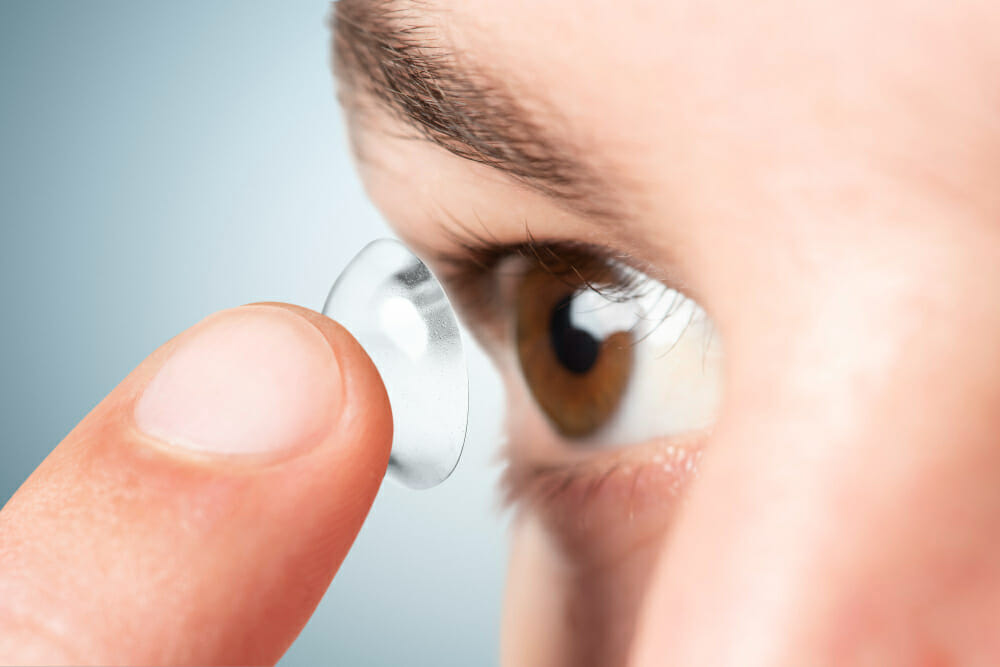Astigmatism is an eye condition which causes blurry or distorted vision. Continue reading to learn more about what causes astigmatism, and how it is treated.
What Causes Astigmatism?
Astigmatism is a refractive error in the eye (similar to myopia--nearsightedness, and hyperopia--farsightedness.) Astigmatism is characterized by unequal curvatures in the lens or cornea. This irregular eye shape leads to blurry vision. According to the American Optometric Association (AOA), most people have some amount of astigmatism, though in many cases it is small enough so as not to be noticeable. Astigmatism can be present from birth or develop later on, and the degree of astigmatism in your eyes can both increase or decrease over time.
Diagnosis and Treatment of Astigmatism
In order to receive a proper diagnosis of astigmatism, you must see an eye doctor for a proper eye exam. During this test, the doctor will measure your eyeball and identify places on the lens or cornea that are causing your astigmatism. Once the test is complete, you will receive your diagnosis, and the doctor will help you prepare a treatment plan.
As with other refractive errors, you can wear eyeglasses or contact lenses to correct astigmatism. If you do not wish to wear glasses or contact lenses, and your astigmatism isn’t too severe, you can consider the surgical route and look into LASIK.
At-Home Exercises Which Can Help Treat Astigmatism
In addition to wearing your glasses or contacts, there are some exercises you can do anywhere that can help treat the symptoms of astigmatism, and may even improve your vision. One exercise commonly used to relieve eye strain is the “20-20-20 Rule”. This entails taking a break for 20 seconds after every 20 minutes spent reading, writing, or looking at a screen to stare at an object 20 feet away.
You can also massage your eye. This is done by placing two fingers on each eyelid, applying gentle pressure, and moving your fingers, slowly, in a circular motion. Alternate between clockwise and counterclockwise.
Read More
Spot It is a fun and educational visual game that comes in many forms and can be used in various ways. There is a version of the game that is suitable for players as young as three years old and up. It is played in groups of two to eight players and there are different themes for the kinds of symbols found in each game. For example, there are some versions that come with images, others with numbers or alphabet, etc. There’s approximately six different games you could play with just one package of Spot It.
The main game is played by identifying matching symbols in different cards which are each filled with a variety of symbols making it challenging to find matching images.
How does Spot It improve your child's vision?
Spot It can help develop different visual skills, including:
- Visual memory
- Visual discrimination
- Visual figure ground perception (this is when one is able to find the forest from the trees)
- Other visual analysis skills
This game is a wonderful example of how educational certain visual activities can be as it helps train our brain and eyes to work together as a team in order to sharpen some important visual skills.
Keratoconus is an eye disorder that causes the cornea to become thinner and more cone shaped. The cornea is the clear layer that covers the front of the eye and contributes greatly to how we see. This corneal disorder causes a lot of visual disturbances due to the progressive thinning and change in shape of the cornea.
If you’ve been diagnosed with keratoconus, there could be a lot of new information to take in which may be confusing. We’d like to debunk some common myths about keratoconus.
Keratoconus is only diagnosed in young people
Age is not a risk factor and anyone can develop keratoconus at any age. It is most common for people to develop keratoconus in their teens and it often continues progressing into the thirties.
Keratoconus causes blindness
This corneal disorder can cause significant visual impairment, and there are cases where it could lead to blindness. However, that being said, keratoconus does not automatically cause blindness and many people with this condition are able to still see, using various optical corrections such as contact lenses or surgical procedures. If keratoconus progresses to the point where there is excessive corneal scarring and the patient can no longer tolerate contact lenses, then there may be a need for a corneal transplant.
The only treatment for keratoconus is corneal transplant
Corneal transplants are the very last resort for extreme cases when no other methods of treatment are sustainable. There are many other effective methods that are used prior to the last option of a transplant. There are a variety of contact lenses ranging from soft lenses to sclerals which allow people with keratoconus to see more clearly. In addition, there are successful procedures such as cross-linking and conductive keratoplasty.
Cross linking cannot be performed over age 40
Age is not a contraindication for this surgery, and therefore it can be performed on patients over age forty. Each individual patient needs to be checked if they are an eligible candidate for this procedure. Cross linking is a minimally invasive method which uses ultraviolet light and eye drops to strengthen the fibers in the cornea. This surgery is the only method that prevents progressive keratoconus from getting worse, as it stabilizes the cornea and slows down the bulging. It has been reported to have a 95% success rate.
If you have any questions about keratoconus, please don’t hesitate to schedule an appointment at our office. Our professional staff will gladly answer all of your questions.
Read More
There are various exercises that prove to be very useful for certain eye conditions, such as stretching the eye muscles.
For example, if someone has crossed eyes, specifically if the eye is turned in too much, otherwise known as over converging, then there is an effective activity that can train the eyes to correct this misalignment. In such a case, there are certain movements when the eyes move out to the extremities which can make the eyes feel very tight. It’s important to strengthen the eye movements in those directions by training the eyes to be able to look that way and overcome the resistance.
There is an exercise which uses occluders to cover both eyes extending past the eyes so they are really well covered. The patient is given the challenge of looking around the occluders which gives them the opportunity to stretch their eye muscles to look out to the extremities and strengthen those tight muscles.
Read More
Innovation, especially where it comes to treatment options for people undergoing vision therapy, can be a great help. More so if that innovation is something easy to do, and requires little more than a tool already in the box.
The Brock string, a commonly used tool in vision therapy, consists of a flexible white cord or string around 10-15 feet in length and colored wooden beads which can be moved along the length of the string.
Typically, it is used to test the ability of the eyes to focus on an object at various distances and therefore useful in working with patients who have issues like convergence insufficiency, amblyopia (lazy eye), and strabismus.
However, a clever modification to the familiar brock string can also be useful to help patients work on their peripheral vision.
This works by adding a clear plastic disk onto the string, and on this disk are two black rings, one on the inside and the other on the outside. As the patient focuses on the bead, they can try to keep the rings on the disk in their peripheral vision.
This helps with the process of going from central to peripheral organization of information, something which is extremely important for things like reading and sports.
A clever new use for a well known tool!
Read More
Can I Sleep With My Contact Lenses?
This may sound like a trick question. Many contact lens wearers will probably answer the question by acknowledging that it can be dangerous to sleep with lenses unless they are designed for overnight usage. But is this accurate?
Sleeping With "Overnight" Lenses: Is It Wise?
Many extended wear contacts are marketed as safe for overnight wear. The truth is that most experts advise against sleeping with ANY type of lens. Many even advise against taking short naps with them.
Studies have shown that even with gas-permeable, silicone, hydrogel lenses designed to improve oxygen flow to the eye, the risk of eye infections from overnight wear is 5-8 times higher. With such a risk, it is evident why many optometrists feel this way.
Signs of Infection
Common symptoms of infection include:
- Pain, irritation, itchiness, and discomfort
- Redness, swelling, discharge, crustiness, and tearing
- Difficulty with blurred/hazy vision
- Difficulty or sensitivity with light or glare
- A sense that something is trapped under the eyelid
If symptoms persist or worsen, speak with an optometrist right away. Part of the risk of infection is that it can lead to more severe eye complications such as ulceration. It is critical that infections are diagnosed and treated early.
Treating Eye Infection
Eye infections may be treated with the following measures:
- Medicated bacterial eye drops for bacterial infection
- Antifungal treatments
- Careful debriding of the eye
- Steroid or corticosteroid treatment
Maintaining Good Habits
Always maintain good habits and hygienic standards for wearing and managing contacts. If you have questions, speak with an optometrist to find out more about appropriate practices. Optimal practices include:
- Properly sterilizing contacts and lens cases with an appropriate lens solution. Never use tap water to clean lenses.
- Never sleeping with any type of contact lens, all of which pose a risk factor for eye infections. All contacts reduce oxygen flow to the eye.
Caring For Our Eyes
Healthy eyes require optimal moisturization and flow of oxygen to the eye. Wearing contacts overnight impedes oxygen flow to the eyes, which makes them susceptible to bacterial and corneal infections. Left untreated, they may result in ulceration and in extreme cases, cause permanent vision loss.
That is why most eye care professionals strongly advise against sleeping with contacts, including those that are deemed safe for overnight usage. The perceived benefit of not having to remove them, is not worth the risk of infection and complications that can damage vision.
Speak to your eye doctor about the risks of sleeping with extended wear lenses. If you have slept with them for a short or extended period of time, or are having difficulty removing them after wearing them overnight, speak with an optometrist right away to find out how to proceed. Never forcefully attempt to remove contacts that are stuck.
Always report signs of eye infections right away to begin early treatment and prevent further eye complications.
Read More
Keratoconus is a progressive disorder in the cornea of the eye. The cornea is the transparent layer that covers the front of the eye and contributes greatly to how well we see. In keratoconus, the cornea becomes thinner and protrudes into a more cone shaped structure which causes a lot of visual disturbances. It usually affects both eyes, but often one eye starts progressing earlier or has a more serious condition than the other. It most commonly affects people aged 10 to 25 and it progresses over around a decade.
Symptoms
The typical symptoms and signs of keratoconus include:
- Blurry distorted vision
- Sudden decrease in vision
- Constant need to change prescription in glasses
- Light sensitivity and glare
Treatment Options
At the very early stages of keratoconus, glasses or soft contact lenses can be an appropriate optical correction but as the condition progresses, these options do not usually provide sufficient correction for people with keratoconus. Patients with keratoconus used to be given hard contact lenses which turned out to be extremely uncomfortable for the shape of their cornea.
Scleral Lenses
Nowadays we have a wonderful optical correction using scleral lenses, which is unique because as opposed to sitting on the cornea, as most lenses do, it sits on the sclera, which is the white part of the eye. This makes this type of lens very comfortable and it prevents the eyelashes from causing discomfort every time the patient blinks.
Surgical Options
There are surgical methods, including cross linking which stabilizes the fibers in the cornea and can be combined with other refractive methods.
When to See the Eye Doctor
If you have any questions or concerns about keratoconus, please schedule an appointment at our office. Our professional staff has extensive experience diagnosing and treating keratoconus.
When most of us think of vision issues, we think of the obvious: clear difficulty seeing either near or far objects. However, there is no shortage of vision issues that are much less obvious, and which can be present even if your child passes their in-school vision test and has 20/20 vision.
For this reason, it is important for your child to have regular comprehensive eye exams. It is also important to know the signs of potential issues. While they might be more difficult to spot, if you know what to look for, you are likely to pick up on them
Frequent Headaches
If your child experiences regular headaches, there is a chance it is due to eye strain as they struggle to focus on either near or far objects. This is often accompanied by squinting, which can provide a little help focusing.
Head Tilting
If your child frequently tilts their head to the side, it can signify an eye alignment issue. The tilting of the head can somewhat correct this issue, and allow them to see better. This symptom can be a sign of strabismus (lazy eye). In addition to this vision issue making it more difficult to see, it can harm their self-esteem in the classroom, if other students find their head tilting strange.
Poor Attention Span
If you notice your child quickly loses interest in activities, schoolwork, or sports (all things which require heavy eye usage for extended periods of time), it can be a sign of an underlying vision issue. This symptom can be a tricky one, as poor attention span is also a symptom of developmental disorders like ADHD. A comprehensive eye exam can conclusively tell you whether your child’s attention span issue is vision-related.
If undetected, vision issues can become more of a hindrance to your child over time, and it can also lead to them being mistakenly thought to have a condition such as ADHD. Being aware of these signs of potential vision problems, and catching them early, can be a huge help to a child presumably already having a more difficult time than most in school, sports, and other activities.
Vision therapy is extremely effective at treating these vision issues and enabling your child to both perform well in, and enjoy, their time in school. If you suspect your child may have a vision issue, be sure to schedule a comprehensive vision exam.
Read More


